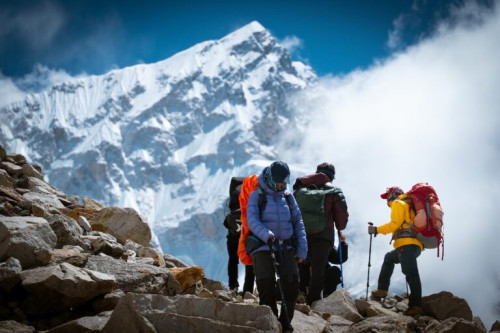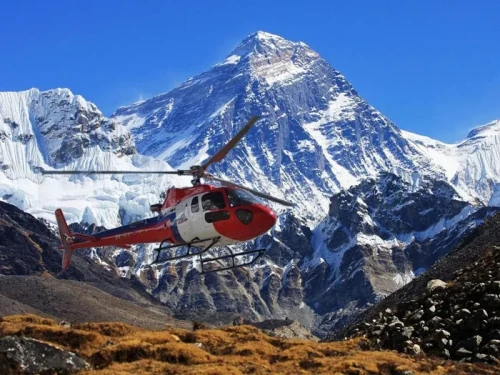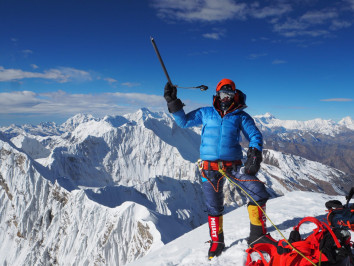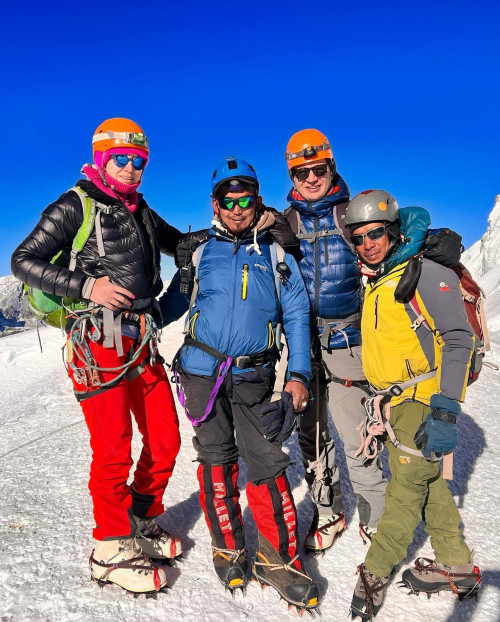Can you summit Everest at 8:00 AM? New Rules, Safety Practical Advice

 Kedar Neupane
12th Aug, 2025
Kedar Neupane
12th Aug, 2025
Kedar Neupane
I am Kedar Neupane, a passionate traveler, entrepreneur, mentor, and social contributor, born and raised in a village near the Nepal-China border in Sindhupalchok, Nepal. With a Master’s degree in Business from Tribhuvan University and Level 2 proficiency in the German language, I have dedicated my life to tourism, trade, mentorship, and holistic well-being.
🌍 A Global Explorer with a Vision
Having explored 26+ countries, I have gained profound insights into diverse cultures, business landscapes, and global tourism. My travels have taken me to:
🇹🇭 Thailand | 🇧🇹 Bhutan | 🇲🇾 Malaysia | 🇸🇬 Singapore | 🇨🇳 China | 🇭🇰 Hong Kong | 🇩🇪 Germany | 🇵🇱 Poland | 🇦🇹 Austria | 🇨🇭 Switzerland | 🇭🇺 Hungary | 🇳🇱 Netherlands | 🇧🇪 Belgium | 🇫🇷 France | 🇦🇪 UAE | 🇬🇧 UK | 🇺🇸 USA | 🇹🇷 Turkey | 🇶🇦 Qatar | 🇮🇳 India | 🇮🇩 Indonesia | 🇨🇦 Canada
Through my journeys, I have developed a deep appreciation for cultural exchange, adventure tourism, and sustainable business practices.
🏔️ Entrepreneurial & Professional Journey
I am actively involved in tourism, trade, and mentorship, leading multiple ventures that promote sustainable travel, adventure tourism, and business development:
✔ Founder & MD – Actual Adventure Pvt. Ltd. (A leading adventure travel company in Nepal)
✔ CEO – Himalayas Destination Management Company (Creating premium travel experiences)
✔ MD – Nepal Export & Import Pvt. Ltd. (Promoting Nepalese products globally)
✔ MD – Actual Mentor Pvt. Ltd. (Empowering entrepreneurs and professionals)
✔ Chairman – World Expedition Nepal (Focusing on high-altitude expeditions and trekking)
Through my entrepreneurial journey, social contributions, global explorations, and commitment to lifelong learning, I strive to inspire others to pursue their passions while making a meaningful difference. My dream is to build a world where travel, business, and holistic well-being come together, fostering growth, sustainability, and happiness for all.
By Kedar Neupane — Updated: August 12, 2025 · Actual Adventure Pvt. Ltd.
Table of Contents
There is no official rule that forces climbers to reach Mount Everest's summit at exactly 8:00 AM. What exists—and what matters for safety—is a time-based turn-back guideline. In simple terms: teams are required to descend if they have not reached the summit by a preset cutoff (commonly enforced as 2:00 PM), to ensure there is enough daylight and favourable conditions for the descent.
Short answer
No. An 8:00 AM summit time is not a blanket rule. Many teams aim to summit in the early morning (often pre-dawn or around first light) for better weather and less crowding, but the official, enforceable policy that matters is the turn-back cutoff rather than a mandatory 8:00 AM summit.
Why timings matter on Everest
Thermal and wind conditions change during the day. Late-summit attempts expose climbers to higher winds, collapsing snow bridges, and the danger of descending in the dark. For these reasons, Nepalese regulators and expedition organizers rely on time-based safety rules.
At-a-glance: what changed in recent seasons
- Stricter eligibility (experience on 7,000m peaks often required).
- Mandatory certified Nepali guides / ban on solo climbs.
- Medical clearances and electronic tracking devices are enforced.
- Higher permit fees and a stronger penalty system for non-compliance.
These measures aim to improve safety, reduce traffic and environmental impact, and ensure better rescue coordination.
What the "2 PM rule" really means
The 2 PM rule is a widely used operational cutoff. It requires climbers to start descending if they have not reached the summit by 2:00 PM local time. The main reasons are:
- Daylight — descent in daylight is far safer than descending in fading light or darkness.
- Weather — afternoon winds typically increase, making fixed ropes and exposed sections more dangerous.
- Reduce escort/sherpa risk — late summits push rescuers and supporting staff into riskier late-day operations.
The exact enforcement (2:00 PM vs. other cutoffs) can vary by operator, season, and local regulator. Expedition leaders often set internal cutoffs that can be earlier than 2:00 PM depending on conditions.
Common misconceptions
- "8:00 AM summit is mandatory" — False. Teams choose summit windows; there's no universal 8:00 AM requirement.
- "You must summit before noon otherwise you're banned" — False. Time-based safety cutoffs are about turning back, not immediate banning. Repeated or dangerous violations however can trigger penalties.
- "Early summit guarantees safety" — Not always. Early starts reduce exposure to afternoon winds but still require proper acclimatisation, logistics, and decision-making.
Key policy changes affecting Everest climbers (recent seasons)
Regulators and stakeholders have introduced several rules designed to make climbing safer and more sustainable. Common measures introduced in and around the 2024–2025 seasons include:
- Experience prerequisites: Many programmes now expect climbers to have prior summits of 7,000m peaks.
- Mandatory guides: Certified Nepali guides must accompany climbers; solo climbs are restricted.
- Medical checks and tracking: Climbers must provide medical certificates and wear GPS trackers for rescue coordination.
- Environmental rules: Zero-tolerance for leaving human waste and trash; deposit/fine systems may apply.
- Stricter penalties: Fines, permit revocation, or bans for serious violations.
These policies are evolving—expedition leaders and climbers should check the latest requirements from the Nepal Government's Department of Tourism and trusted expedition operators well before departure.
Practical advice for climbers planning summit day
- Plan an early start: Most teams leave Camp IV (South Col) late at night to reach the summit around dawn. This reduces congestion and exposure to the afternoon weather window.
- Stick to your turnaround time: Decide a firm turnaround time (e.g., 2:00 PM) before you go. Communicate it to your team.
- Monitor conditions: Wind, visibility and rope condition can change rapidly — be ready to abort.
- Follow your guide: Certified Nepali guides have local knowledge and experience about timing, bottlenecks and conditions.
- Training and experience: Have high-altitude experience, including prior 7,000m climbs if required by your operator or permit rules.
FAQ
Can you summit Everest at 8:00 AM? — New Rules, Safety & Practical Advice
Can you summit Mount Everest at 8:00 AM? Clearing up the "8 AM" rule
FAQ
Q: If there's no 8 AM rule, why do people talk about specific summit times?
A: Teams often aim for specific summit windows—usually between dawn and 9 AM—to take advantage of calmer winds, more stable snow conditions, and reduced crowding at the Hillary Step and other bottlenecks. These operational decisions also maximise daylight for the descent. While widely practiced, these timings are based on experience and weather patterns, not a formal legal mandate.
Q: Can I set my own summit time with a private operator?
A: Yes, within reason. Private operators can tailor summit attempts to client fitness, acclimatisation levels, and the forecasted weather window. However, even private schedules must respect mandatory safety cutoffs (e.g., the 2:00 PM turn-back rule) and follow route management protocols established by the authorities and rope-fixing teams. Your guide has the final say if conditions demand an earlier or later push.
Q: What happens if I ignore a turn-back order?
A: Disregarding a turn-back order exposes you to extreme risks like frostbite, high-altitude cerebral edema (HACE), and sudden weather changes. It can also endanger your Sherpa guides and fellow climbers who may be forced into late-day rescues. From a regulatory perspective, ignoring such orders can lead to fines, loss of climbing permits, disqualification from future seasons, and even lifetime bans from Nepal's mountains. Expedition companies may also refuse to work with you again.
Q: Are there other time-based rules I should know?
A: Yes. In addition to the 2:00 PM summit cutoff, time constraints may be imposed by rope-fixing schedules (you cannot climb before the ropes are in place), weather windows that can open or close within hours, and the availability of helicopter or ground rescue services which usually operate only during daylight. Furthermore, congestion management on narrow ridgelines means teams are sometimes assigned specific start times from Camp IV to avoid dangerous traffic jams.
Conclusion
There is no official 8:00 AM summit rule. The governing safety concept is the time-based turnaround / cut-off (commonly 2:00 PM) and operator-specific summit windows. Aim for an early summit for safety and smoother logistics, but rely on your guide's decisions and established cutoffs rather than a fixed clock-time requirement.
If you're organizing an expedition or planning to climb Everest this season, check permit rules, medical and experience requirements, and work with a reputable operator who enforces clear turnaround times and safety protocols.
Written by Kedar Neupane · Actual Adventure Pvt. Ltd actual-adventure.com
Want this article adapted for your website or printed as a PDF? Reply with your preferred format and I'll prepare it.
Recent Posts

18th Nov, 2025

14th Nov, 2025

12th Nov, 2025

28th Oct, 2025

19th Oct, 2025

18th Oct, 2025

14th Oct, 2025

14th Oct, 2025

















